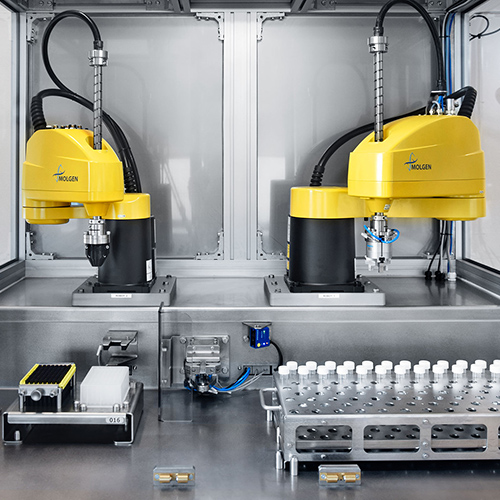Extremely high sample throughput rates

If there’s one thing the corona pandemic has taught us, it is that laboratories place tremendous importance on high sample throughput rates. Even with highly qualified laboratory personnel, this demand can no longer be met. There’s no getting round the automation of laboratory processes. That’s why MolGen in the Netherlands developed PurePrep TTR, which can prepare 320 patient samples per hour for molecular downstream processing. And the Dutch company uses laboratory-specific automation technology from Festo.
MolGen is a global total solutions provider in DNA/RNA technology of hardware, reagents, consumables, software and service for which can be used for human and animal diagnostics, the agriculture and biotech industries. MolGen challenges the status quo in Life Sciences with a high-tech automated workflow that is customizable to our customers’ specific needs.
“When we founded MolGen, our primary field of business was high rates of sample throughput in genetic engineering laboratories for animals and plants. We had a great deal of knowledge about the chemicals required to this end,” explains Niels Kruize, CEO of MolGen and one of the company’s three founders.
Rapid growth
During the corona pandemic, laboratories were ramped up on a large scale because high sample throughput rates were absolutely essential. “This is where MolGen got involved, and in a very short time, within 2 to 3 years, we’ve grown from five to currently more than 130 employees,” explains Kruize, making reference to branch locations in the Netherlands, as well as in the UK and the US.
Recent developments include the PurePrep TTR handling unit. It’s used for automated handling of liquids at high throughput rates by quickly, accurately and reliably transferring them from sample vials to microwell plates. “The automated PurePrep TTR has a throughput rate of 320 samples per hour,” says Kruize. Even laboratory assistants with good training and lots of professional experience are unable to match this tremendous throughput rate,” he adds.
Laboratory staff for more demanding tasks
Despite the expert skills of trained laboratory staff, errors can nevertheless occur which lead to contamination. The individual steps of grasping a sample, unscrewing the cap, putting the cap down, removing the liquid with a pipette and transferring it to a microwell plate are time-consuming and cumbersome. The sample vials and the plates are labelled with barcodes which are read by scanners in order to monitor and track the samples throughout the entire work process. “Automating these process steps makes it possible to deploy highly qualified laboratory personnel much more effectively for more demanding tasks, such as analysing test results.”
Trustful collaboration
“I’ve already been working together with Festo for ten years, especially with Festo’s national company in the Netherlands,” reports the CEO from MolGen. He describes this collaboration as exceptional, because Festo is always prepared to do more than just sell standard products. “Their Innovation Unit caters to our requirements and provides us with modules for pilot projects. This was the case with the CPX-E controller and now again with the Magic Box, as we call it – the decentralised pressure and vacuum generator PGVA,” says Kruize and adds: “We were among the first, maybe even the very first, to use it.”
Decentralised pressure and vacuum supply
“This is more or less hidden in the machine housing,” explains Bert Baas, Dutch sales engineer for laboratory automation at Festo. The PGVA integrates compressor, air preparation including filter system, reservoir and electronic pressure and vacuum control in the smallest of spaces. “In order to meet the
huge demand during the corona pandemic, we turned the pressure and vacuum generator over to MolGen while it was still in the technical approval phase,” reports Baas.
“The PGVA reveals the passion for automation demonstrated by Festo’s various teams, which results in successful collaborative solutions for us. This builds confidence in the supplier’s ability to produce prototypes and systems much faster and more flexibly,” concludes the MolGen CEO.
Pressure controlled pipetting
The pipetting head DHOE is used for the pipetting process. It’s capable of transporting extremely small pipetting volumes of down to 1 µl with utmost pipetting precision. An open pipetting system with pipetting head DHOE for simple liquid transport makes it possible to configure the most important pipetting functions based on requirements, and to expand them flexibly – the system is also compatible with large pipette tips. Thanks to its outstanding chemical resistance, the pipetting head can be used for a wide range of liquids with varying viscosities.
“The pipetting process can be adjusted very precisely thanks to the pressure-controlled operating principle. This isn’t possible with a syringe-based system. The know-how lies clearly in liquid level detection,” says laboratory automation specialist Kruize enthusiastically.
Sample handling with precise level detection
The first robot arm of the PurePrep TTR, which is equipped with two SCARA robots, grasps a sample vial by the cap with an electric gripper and brings it into a position at which the cap is removed. After opening, the second robot arm uses pipetting head DHOE to transport the liquid from the sample vial to the microwell plate. “The pipetting system is even capable of precisely determining the liquid level in a sample vial by means of high-precision pressure and vacuum adjustment via the PGVA,” explains Bastiaan Ebbelaar, application specialist at MolGen. For Ebbelaar, level detection is the system’s most fascinating feature. Concurrent to liquid handling, the first robot arm closes the open sample vial and returns it to the rack. Then it continues with the next sample vial.
Watch our interview with Molgen here
Our free liquid handling resources...
Do you need to know the basics of designing a pneumatic dispensing system? Upgrade your pneumatics know-how to reach your optimum liquid handling throughput. Download our seven page whitepaper.
How to set up your liquid handling system in four steps! Remove the risk of making costly mistakes with automated liquid dispensing. Download our four step guide here.





















